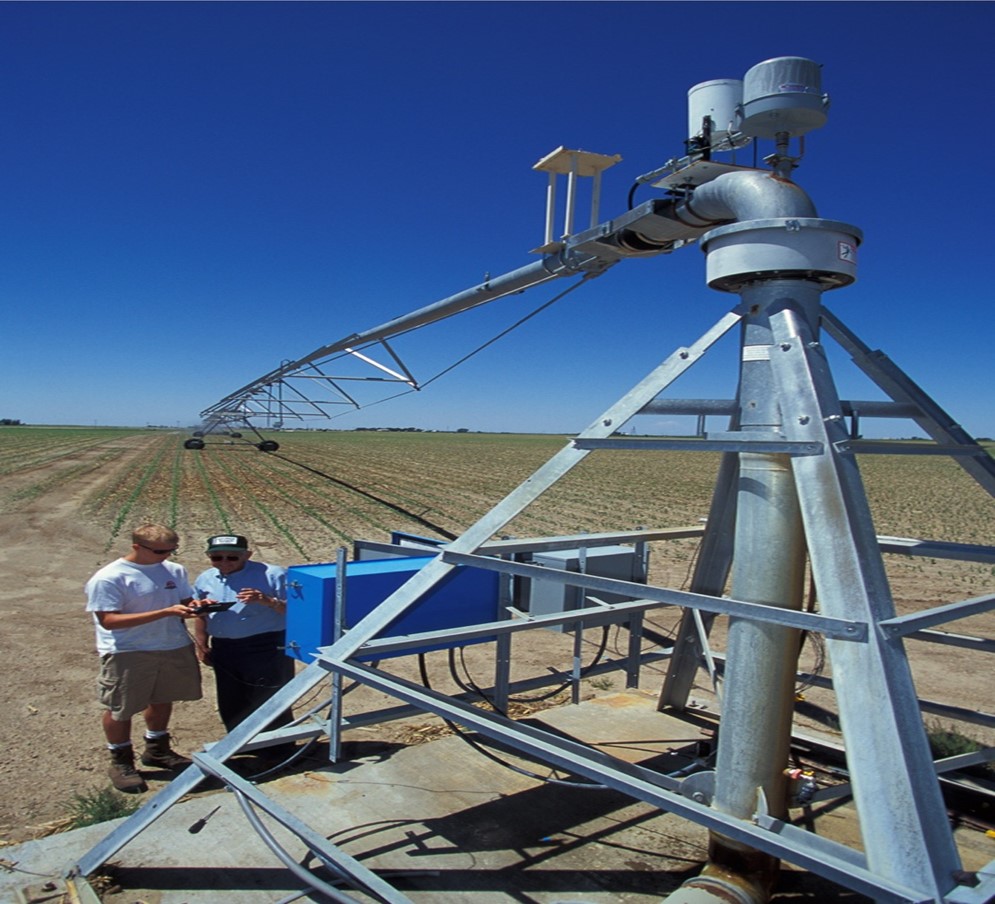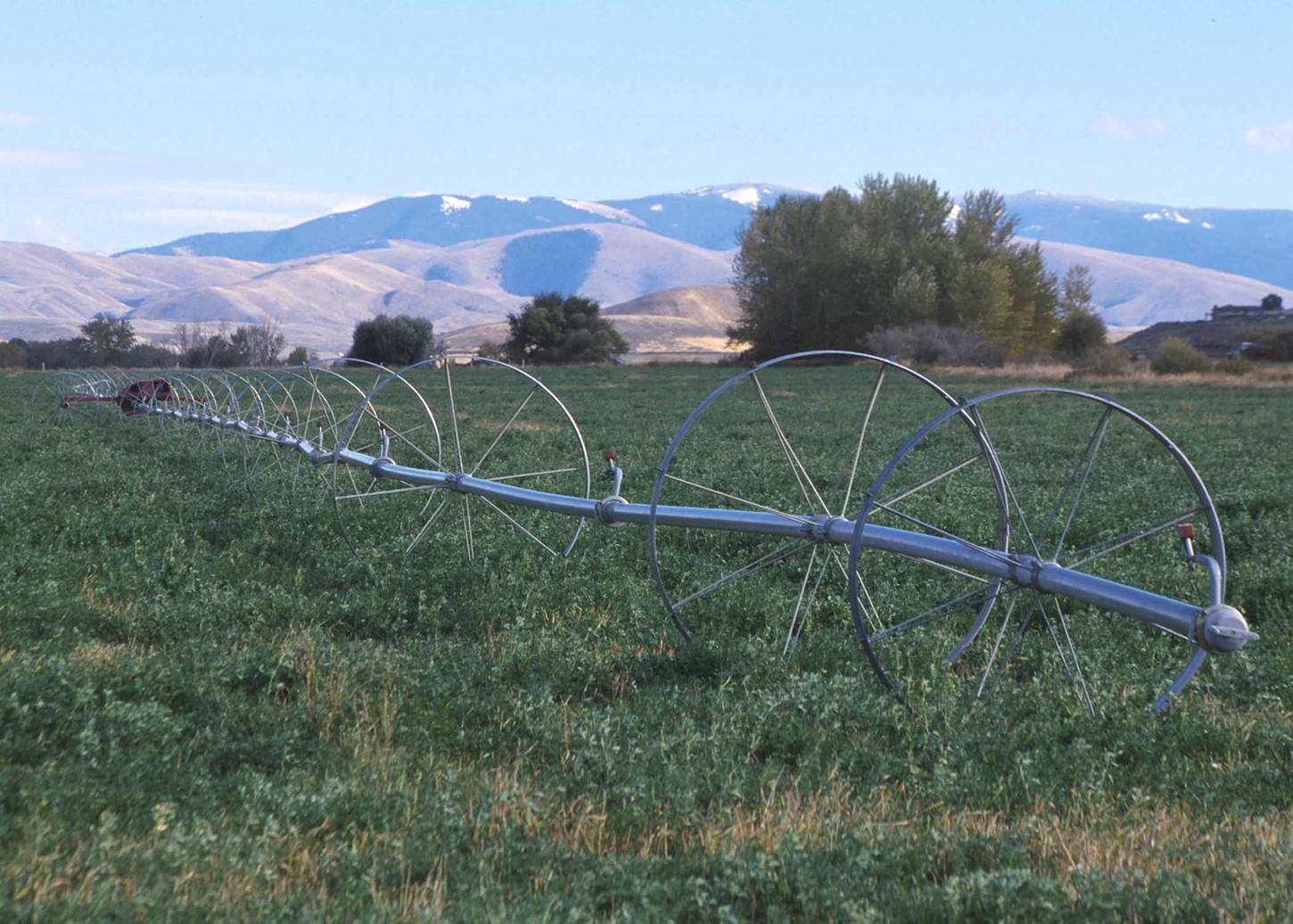Various types of irrigation techniques differ in how the water obtained from the source is distributed within the field. In general, the goal is to supply the entire field uniformly with water, so that each plant has the amount of water it needs, neither too much nor too little. The modern methods are efficient enough to achieve this goal.
Surface Irrigation
In surface irrigation systems, water moves over and across the land by simple gravity flow to wet it and infiltrate it into the soil. Surface irrigation can be subdivided into the furrow, border strip or basin irrigation. It is often called flood irrigation when the irrigation results in flooding or near flooding of the cultivated land. Historically, this has been the most common method of irrigating agricultural land.
Where water levels from the irrigation source permit, the levels are controlled by dikes, usually plugged by soil. This is often seen in terraced rice fields (rice paddies), where the method is used to flood or control the level of water in each distinct field. In some cases, the water is pumped, or lifted by human or animal power to the level of the land.
Click here for an explanation of the flood irrigation system.
Klik hier om na ’n verduideliking van vloed besproeiing te luister.
Localized Irrigation
Localized irrigation is a system where water is distributed under low pressure through a piped network, in a pre-determined pattern, and applied as a small discharge to each plant or adjacent to it. Drip irrigation, spray or micro-sprinkler irrigation and bubbler irrigation belong to this category of irrigation methods.
Drip Irrigation
Drip irrigation, also known as trickle irrigation, functions as its name suggests. Water is delivered at or near the root zone of plants, drop by drop. This method can be the most water-efficient method of irrigation if managed properly since evaporation and runoff are minimized. In modern agriculture, drip irrigation is often combined with plastic mulch, further reducing evaporation, and is also the means of delivery of fertilizer. The process is known as fertigation.

Drip Irrigation Layout and its parts
Deep percolation, where water moves below the root zone, can occur if a drip system is operated for too long of a duration or if the delivery rate is too high. Drip irrigation methods range from very high-tech and computerized to low-tech and labour-intensive. Lower water pressures are usually needed than for most other types of systems, except for low energy centre pivot systems and surface irrigation systems, and the system can be designed for uniformity throughout a field or for precise water delivery to individual plants in a landscape containing a mix of plant species.
Although it is difficult to regulate pressure on steep slopes, pressure compensating emitters are available, so the field does not have to be level. High-tech solutions involve precisely calibrated emitters located along lines of tubing that extend from a computerized set of valves. Both pressure regulation and filtration to remove particles are important. The tubes are usually black (or buried under soil or mulch) to prevent the growth of algae and to protect the polyethene from degradation due to ultraviolet light. But drip irrigation can also be as low-tech as a porous clay vessel sunk into the soil and occasionally filled from a hose or bucket.
Subsurface drip irrigation has been used successfully on lawns, but it is more expensive than a more traditional sprinkler system. Surface drip systems are not cost-effective (or aesthetically pleasing) for lawns and golf courses. In the past one of the main disadvantages of the subsurface drip irrigation (SDI) systems, when used for turf, was the fact of having to install the plastic lines very close to each other in the ground, therefore disrupting the turf grass area. Recent technology developments on drip installers place the line underground and cover the slit, leaving no soil exposed.
Sprinkler Irrigation

Sprinkler irrigation
In sprinkler or overhead irrigation, water is piped to one or more central locations within the field and distributed by overhead high-pressure sprinklers or guns. A system utilizing sprinklers, sprays, or guns mounted overhead on permanently installed risers is often referred to as a solid-set irrigation system. Higher pressure sprinklers that rotate are called rotors and are driven by a ball drive, gear drive, or impact mechanism.
Motors can be designed to rotate in a full or partial circle. Guns are like rotors, except that they generally operate at very high pressures of 40 to 130 lbf/in² (275 to 900 kPa) and flows of 50 to 1200 US gal/min (3 to 76 L/s), usually with nozzle diameters in the range of 0.5 to 1.9 inches (10 to 50 mm). Guns are used not only for irrigation but also for industrial applications such as dust suppression and logging.

A travelling sprinkler
Sprinklers can also be mounted on moving platforms connected to the water source by a hose. Automatically moving wheeled systems known as travelling sprinklers may irrigate areas such as small farms, sports fields, parks, pastures, and cemeteries unattended. Most of these utilize a length of polyethene tubing wound on a steel drum. As the tubing is wound on the drum powered by the irrigation water or a small gas engine, the sprinkler is pulled across the field. When the sprinkler arrives back at the reel the system shuts off. This type of system is known to most people as a "water reel" travelling irrigation sprinkler and they are used extensively for dust suppression, irrigation, and land application of wastewater. Other travellers use a flat rubber hose that is dragged along behind while the sprinkler platform is pulled by a cable. These cable-type travellers are old technology and their use is limited in today's modern irrigation projects.
Click here for an explanation of the sprinkler irrigation system.
Klik hier om na ’n verduideliking van sprinkler besproeiing te luister.
Click here for an explanation of the drip and micro-irrigation systems.
Klik hier om na ’n verduideliking van drup en mikro besproeiing te luister.
Center Pivot Irrigation

A small centre pivot system from beginning to end

The hub of a centre-pivot irrigation system

Rotator style pivot applicator sprinkler
Centre pivot irrigation is a form of sprinkler irrigation consisting of several segments of pipe (usually galvanized steel or aluminium) joined together and supported by trusses, mounted on wheeled towers with sprinklers positioned along its length. The system moves in a circular pattern and is fed with water from the pivot point at the centre of the arc. These systems are found and used in all parts of the nation and allow irrigation of all types of terrain. Newer irrigations have drops as shown in the image that follows.

Centre pivot with drop sprinklers

Wheel line irrigation system
Click here to view a video on centre pivot irrigation.
Click here to view a video on subsurface drip irrigation.
Lateral Move (Side Roll, Wheel Line) Irrigation
A series of pipes, each with a wheel of about 1.5 m diameter permanently affixed to its midpoint and sprinklers along its length, are coupled together at one edge of a field. Water is supplied at one end using a large hose. After sufficient water has been applied, the hose is removed and the remaining assembly rotated either by hand or with a purpose-built mechanism so that the sprinklers move 10 m across the field.
The hose is reconnected. The process is repeated until the opposite edge of the field is reached. This system is less expensive to install than a centre pivot, but much more labour intensive to operate, and it is limited in the amount of water it can carry. Most systems utilize 4 or 5-inch (130 mm) diameter aluminium pipe. One feature of a lateral move system is that it consists of sections that can be easily disconnected. They are most often used for small or oddly shaped fields, such as those found in hilly or mountainous regions, or in regions where labour is inexpensive.
Sub-Irrigation
Sub-irrigation also sometimes called seepage irrigation has been used for many years in field crops in areas with high water tables. It is a method of artificially raising the water table to allow the soil to be moistened from below the plants' root zone. Often those systems are located on permanent grasslands in lowlands or river valleys and combined with drainage infrastructure. A system of pumping stations, canals, weirs and gates allows it to increase or decrease the water level in a network of ditches and thereby control the water table.
Sub-irrigation is also used in commercial greenhouse production, usually for potted plants. Water is delivered from below, absorbed upwards, and the excess is collected for recycling. Typically, a solution of water and nutrients floods a container or flows through a trough for a short period of time, 10–20 minutes, and is then pumped back into a holding tank for reuse. Sub-irrigation in greenhouses requires sophisticated, expensive equipment and management. Advantages are water and nutrient conservation, and labour-saving through lowered system maintenance and automation. It is similar in principle and action to subsurface drip irrigation.